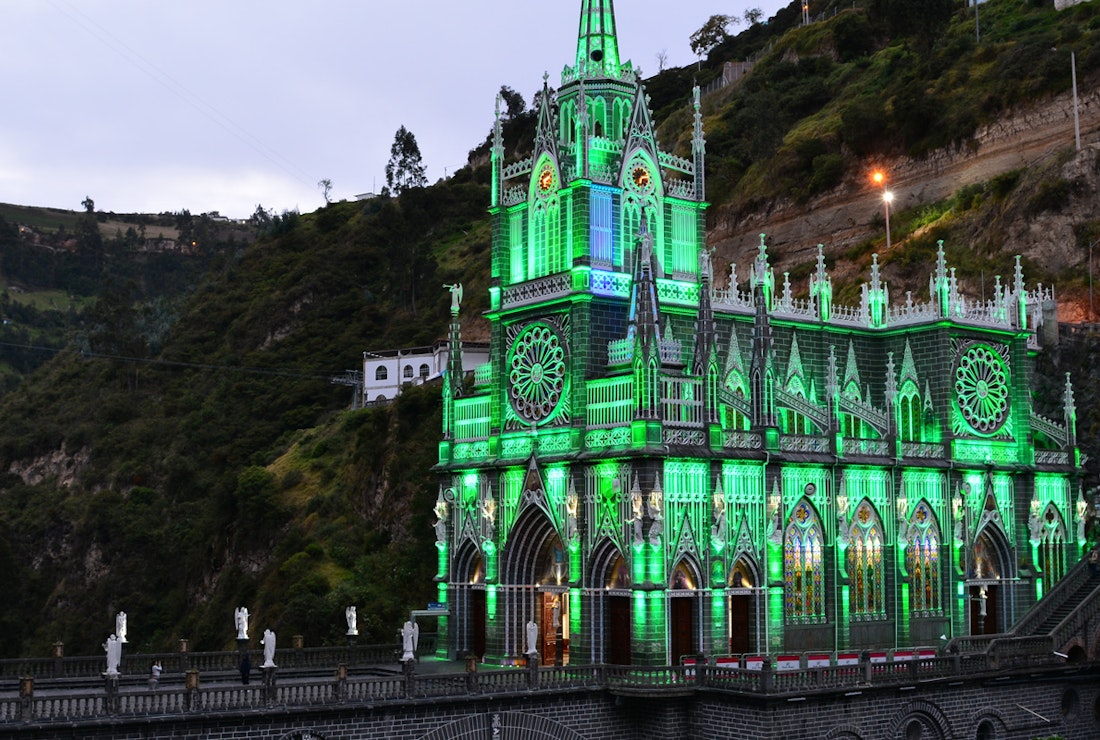
This one is hard for the skeptics.
How to dismiss off-handedly an image that appears not on a mere surface (though that’s plenty impressive, when authentic), not just on the contours of stone — say, at a cave — but penetrates into the rock itself?
Yet this is apparently the case with the Virgin of Las Lajas in Colombia.

The year: 1754, As the story goes, mother and daughter sought shelter in the Las Lajas gorge, and Rosa, to her mother’s surprise, seemingly started to interact with apparitions of the Virgin Mary and the Christ Child.
Other accounts say they both saw apparitions of Mary and Jesus, and that the image appeared later, discovered when villagers went to see the site.
Shades of Guadalupe two centuries before.
And if true (which all indicators say it is), is as unbelievable as what occurred in Mexico City.
According to yet a third account, María had found a cave in the cliff, in which she took refuge, but was filled with fear, for “it was said that in those parts, apparitions of the devil were commonplace. Therefore, if she left the cave she ran the risk of falling headlong into the river, but if she remained inside she might find herself face to face with the evil spirit. In this situation, Maria implored the protection of the Virgin of the Rosary, a very popular invocation in the region. After formulating her prayer, she felt someone touch her shoulder, but turning to look behind her, she saw no one… Terrified, she fled from her shelter, even though a mysterious attraction urged her not to leave that area.
“Some days later, Maria returned to the cave, carrying on her back her little daughter Rosa, who had been born deaf and mute. Arriving at the place, she sat down to rest; she had barely done so when the ‘mute’ girl said: ‘Mama, mama! Look at this white Lady with a little boy in her arms.’ Hearing her daughter’s voice for the first time, Maria’s heart was filled with joy! But as she saw no other person there, the joy of the miracle was followed by fear. She took the child and left.”
Later, when Rosa went missing from home, Maria knew to find her at the cave, where to her astonishment she saw her daughter playing with an apparitional Child, watched over by an apparitional woman, soon identified as Mary.
When Rosa miraculously regained her ability to hear and speak after these incidents, word of the miracle had spread, and the site became a place of pilgrimage. Some say at one point Rosa had taken ill and seemed dead but came back to life miraculously, after Maria carried her body to the holy spot and lay it before Mary.
“With great emotion and rejoicing, the Indian woman and her daughter hastened to the town of Ipiales to announce the happening,” said Catholic Magazine (for our discernment). “It was already late at night when they arrived there, and the parish bells began to peal miraculously. The faithful, curious to know what was happening, made their way to the little church. When everyone had gathered there, they listened to Maria’s account, and with their own eyes they saw the little girl, previously dead, now alive before them.”

In the beautiful image, Our Lady is holding the Child Jesus and handing St. Dominic a rosary; the Child Jesus is extending a friar’s cord to St. Francis of Assisi.
The image has survived intact for several centuries despite being exposed to the elements in an open gorge. The colors remain vibrant and the details of the image clear, which believers view as evidence of its supernatural origin and protection.
The Catholic Church, acknowledging its significance, designated the august sanctuary commemorating it as a minor basilica in 1954. Today, thousands of pilgrims from around the world visit the shrine, seeking blessings, healing, and spiritual renewal.
The first shrine was built by local believers in the late 18th century. In 1802, a larger shrine was constructed, and finally, in the early 20th century, the current neo-Gothic basilica was built, which stands till today.
The Virgin of Las Lajas holds a special place in the hearts of Colombian Catholics and pilgrims worldwide. The sanctuary’s architectural grandeur is as fascinating as its history and religious significance. Built between 1916 and 1949, the current Las Lajas Sanctuary stands as a brilliant example of the Gothic Revival architectural style. Its design takes advantage of the natural surroundings, with one side of the church built into the canyon, while the other side overlooks the river below. The two tall towers, a beautiful rose window, and the stone bridge spanning the river all contribute to the sanctuary’s majestic aura.
The Virgin of Las Lajas is more than a religious icon. Its stunning architectural features stand as a testament to human ingenuity and its important role as a beacon of spirituality, artistry, and cultural identity. It not only symbolizes the faith of a nation but also its resilience and fervor, thereby standing as an emblem of hope on the world stage in need of it.



